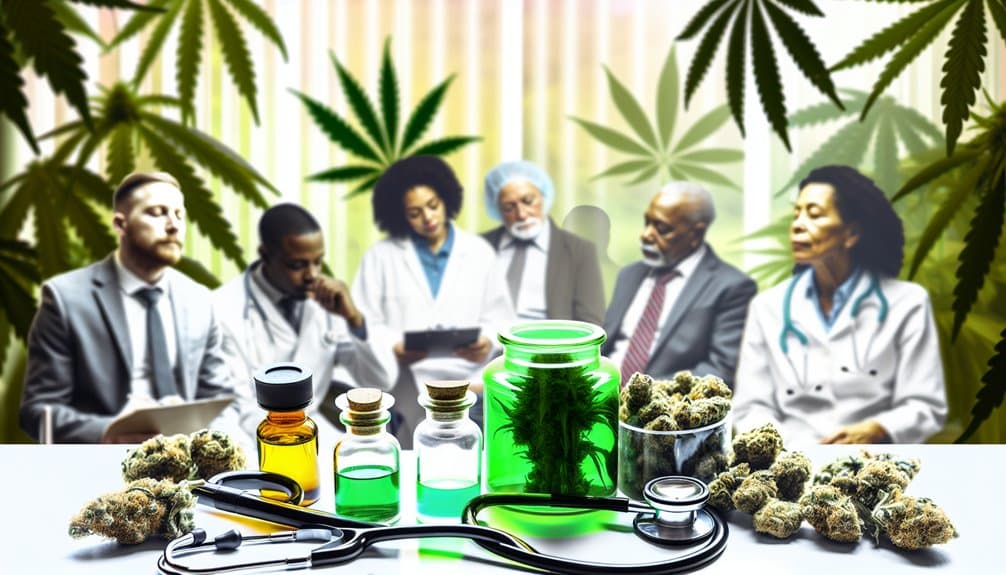As you explore the world of medical marijuana, you'll discover a range of therapeutic applications. It's known to offer relief for chronic pain, neurological conditions, and psychological issues, with evidence supporting its efficacy. Medical marijuana can be consumed orally, inhaled, or applied topically, each with unique benefits and challenges. However, it's not without its downsides, such as potential dependence and health risks. As the stigma lessens and research progresses, these patient experiences are shaping our understanding of medicinal cannabis. Are you ready to dive deeper into this evolving landscape?
The History and Evolution of Medical Marijuana

While it may seem like a recent development, the medical use of marijuana has a long and complex history that spans multiple continents and centuries. You'd be fascinated to know that therapeutic use of cannabis traces back to 2700 BC. Cultural perceptions began altering when Irish physician William O'Shaughnessy introduced cannabis to Western medicine in 1839. The medicinal change took a backseat in 1937 when the Marihuana Tax Act greatly curtailed its medical use. However, since California's Compassionate Use Act in 1996, we've seen a resurgence of its medicinal application. Despite the complex regulatory landscape, the commitment to serving others has driven research, leading to the Medical Marijuana and Cannabidiol Research Expansion Act in 2022. This history underlines the evolving perspective towards medical marijuana. The Controlled Substances Act of 1970, which classified cannabis as a Schedule I drug with no accepted medical use, was another major hurdle to its medical application.
Understanding the Therapeutic Potential of Marijuana
Given the rich history of medical marijuana's use and the ongoing research into its potential applications, it's clear that this plant holds considerable promise for the medical field. Your understanding of its therapeutic benefits is vital. Patient testimonials and clinical trials affirm its effectiveness in managing chronic pain, providing a safer alternative to opiates, and improving quality of life. It's also been found helpful for neurological conditions, including multiple sclerosis and certain seizure disorders. An interesting study in Peru has demonstrated the variability in cannabinoid concentrations in different cannabis samples, which could potentially be leveraged for targeted medicinal applicationsvariability in cannabinoid concentrations. Cancer patients have benefited from its ability to manage nausea, stimulate appetite, and enhance overall well-being. Further, it's shown promise in treating psychological conditions, such as anxiety and depression, and other conditions like irritable bowel syndrome and sleep disorders. Its unique ability to address multiple symptoms simultaneously is truly remarkable.
The Role of Cannabinoids in Medical Treatment

Although marijuana is often associated with recreational use, it's the plant's cannabinoids that play an essential role in medical treatments. The cannabinoid mechanisms have shown effectiveness in controlling nausea and vomiting, especially in adults undergoing chemotherapy. They're an integral part of pain management, offering significant reduction in chronic pain symptoms and neuropathic discomfort. Studies have also demonstrated the therapeutic applications of cannabinoids in managing muscle spasticity, particularly in multiple sclerosis patients. Beyond these, cannabinoids have shown promise in improving sleep, increasing appetite in HIV and AIDS patients, and reducing tics in Tourette syndrome. While more research is necessary, it's clear that the role of cannabinoids in medical treatment is vast and impactful.
Common Medical Conditions Treated With Marijuana
If you're coping with chronic pain, you're not alone. Medical marijuana has become a lifeline for many, providing relief where other medications have failed. Here's how it's used:
- Chronic pain: An astounding 94% of Colorado medical marijuana ID cardholders use it for this. It's effective for pain related to multiple sclerosis and nerve damage.
- Neurological conditions: It's used for muscle spasms in multiple sclerosis, seizures in Lenox-Gastaut and Dravet syndromes, and may help with ALS symptoms.
- Gastrointestinal conditions: It controls nausea and vomiting from chemotherapy, boosts appetite in HIV/AIDS and cancer patients, and may relieve Crohn's disease symptoms.
- Mental health: It's used to treat anxiety, insomnia, PTSD symptoms and possibly depression.
Different Forms of Medical Marijuana: Smoking, Edibles, and More

Understanding the various forms of medical marijuana is essential as it's not just about smoking a joint anymore. Inhalation methods, like smoking and vaporizing, deliver quick effects but carry potential lung risks. Oral forms, including edibles, oils, and capsules, offer a lung-sparing technique, though they can be slower acting and harder to dose. Topical applications, such as creams and patches, provide localized relief without psychoactive effects. Finally, alternative techniques like sublingual drops and suppositories present unique administration routes. Each form has its merits and drawbacks, and the choice should align with your specific needs and lifestyle. By exploring these options, you can make informed decisions about the most suitable method for your medical condition.
Methods of Administering Medical Marijuana: Pros and Cons
While considering medical marijuana use, it's critical to comprehend the various administration methods and their respective pros and cons.
- Oral intake, although easy, presents dosage variability due to absorption rates and delayed onset of action.
- Inhalation provides rapid relief but raises concerns about the variable mixture of substances and potential respiratory issues.
- Topical application offers localized relief without systemic effects, but its effectiveness varies.
- Other routes like sublingual tablets and transdermal patches offer quicker absorption but have variable efficacy.
Your administration preferences depend on your specific needs and the potential side effects you're willing to manage. Remember, the goal is to maximize benefits while minimizing adverse effects. Always consult with your healthcare provider to determine the best method for you.
Patient Experiences: The Benefits and Risks of Marijuana Use

Delving into patient experiences with medical marijuana, we find a variety of reported benefits and risks. Patient testimonials highlight significant relief from chronic pain, improved sleep, mental health benefits, and a better quality of life. This relief often allows for more active, normal lives and less reliance on prescription medications. However, it's not all positive. Cannabis experiences can also introduce risks, including dependence, addiction, and various health complications. Some patients report lowered testosterone levels and hallucinations. In addition, many users lack medical supervision due to legal and social implications, leading to potential misuse. Despite the benefits, the risks underscore the need for careful consideration, additional research, and open patient-doctor communication.
The Legal Landscape: Medical Marijuana Laws Across the Globe
Steering through the global legal landscape of medical marijuana reveals a complex patchwork of laws that vary considerably from one country to the next. You'll find countries like Germany and Chile with fully legalized medical marijuana, others like Denmark and Ecuador pioneering pilot programs or decriminalization. Each region, from Latin America to Oceania, crafts unique regulatory frameworks to navigate this evolving field.
International trends suggest a gradual shift towards acceptance:
- International investments in countries like Macedonia and Lesotho are booming.
- Prominent medical organizations globally advocate for medical cannabis use.
- Cannabis-derived pharmaceuticals gain authorization in multiple countries.
- Regulatory bodies like Israel's IMCA establish stringent guidelines.
Understanding these global regulations is essential for anyone committed to serving others in this domain.
The Stigma Around Marijuana Use: Breaking Down Misconceptions

Despite the increasing acceptance and legalization of marijuana for medicinal purposes worldwide, a strong stigma persists. Stemming from historical prejudices, laws, and negative media portrayals, this stigma impacts both recreational and medical users. You might have heard that marijuana causes long-term memory loss or is a gateway to harder drugs, yet these misconceptions have been debunked. Studies show medical marijuana effectively manages conditions like chronic pain, anxiety, and insomnia. Still, stigma results in patients fearing judgment and avoiding discussion with their doctors. Stigma reduction and public education are key to shifting perceptions. As people grow more informed about marijuana's medical benefits, the hope is for a future where patients can openly discuss their use without fear.
The Future of Medical Marijuana: Trends and Predictions
As we look ahead, the future of medical marijuana promises fascinating trends and predictions across legal and regulatory landscapes, medical research and applications, technological innovations, and market growth.
Consider these developments:
- Legislative changes are enhancing patient accessibility and encouraging market expansion.
- Cutting-edge research is revealing new uses for cannabis in healthcare, offering personalized, effective treatments.
- Future innovations in technology, involving AI and VR, are revolutionizing cannabis cultivation, retail, and patient education.
- The global market is set to explode, with the U.S. alone projected to reach $44.3 billion by 2025.
These advancements are not only reshaping the industry but also opening doors to better patient care and wellness. Keep an eye on these trends as they redefine what medical marijuana means for patients and practitioners alike.
Conclusion
As you navigate the world of medical marijuana, remember it's not a miracle cure-all, but its potential is undeniable. From easing chronic pain to calming neurological storms, its benefits can redefine one's quality of life. Still, it's essential to weigh the potential risks and legal implications. Despite lingering stigma, the future of medical marijuana is brighter than a supernova. As research progresses, it promises a revolution in healthcare, potentially transforming countless lives.
If you're curious to learn more about how medical marijuana could benefit you or a loved one, I invite you to visit Fells Point Cannabis Docs of Maryland. Our friendly team is here to answer your questions and guide you through the process. Feel free to give us a call at (410) 401-4200—we'd love to chat with you and help you explore your options!
